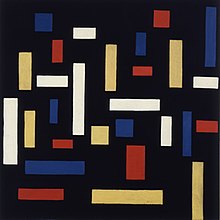
Back دي ستايل Arabic دى ستيل ARZ De Stijl AST Дэ Стэйл Byelorussian Де Стил Bulgarian De Stijl Breton De Stijl BS De Stijl Catalan De Stijl Czech De Stijl Welsh
 Theo van Doesburg, Composition VII (the three graces), 1917 | |
| Years active | 1917–1931 |
|---|---|
| Location | The Netherlands |
| Major figures | Theo van Doesburg, Piet Mondrian, Gerrit Rietveld, J.J.P. Oud, Bart van der Leck |
| Influences | |
| Influenced | |
De Stijl (/də ˈstaɪl/, Dutch: [də ˈstɛil]; "The Style"), incorporating the ideas of Neoplasticism, was a Dutch art movement founded in 1917 in Leiden, consisting of artists and architects.[1] The term De Stijl is also used to refer to a body of work from 1917 to 1931 created in the Netherlands.[2][3] Proponents of De Stijl advocated pure abstraction and universality[disambiguation needed] by a reduction to the essentials of form and colour. They simplified visual compositions to vertical and horizontal, using only black, white and primary colors.
De Stijl is also the name of a journal—published by the Dutch painter, designer, writer, and critic Theo van Doesburg—that propagated the group's theories. Along with van Doesburg, the group's principal members were the painters Piet Mondrian, Vilmos Huszár, Bart van der Leck, the architects Gerrit Rietveld, Robert van 't Hoff, the sculptor and painter Georges Vantongerloo, the architect J. J. P. Oud and the writer Anthony Kok. The artistic philosophy that formed a basis for the group's work is known as Neoplasticism—the new plastic art (or Nieuwe Beelding in Dutch).
According to van Doesburg in the introduction of the De Stijl, the movement was a reaction to the Dutch expressionist architecture of the Amsterdam School movement.
- ^ Linduff, David G. Wilkins, Bernard Schultz, Katheryn M. (1994). Art past, art present (2nd ed.). Englewood Cliffs, N.J.: Prentice Hall. pp. 523. ISBN 978-0-13-062084-2.
{{cite book}}: CS1 maint: multiple names: authors list (link) - ^ "De Stijl". Tate Glossary. The Tate. Archived from the original on 11 February 2017. Retrieved 31 July 2006.
- ^ Curl, James Stevens (2006). A Dictionary of Architecture and Landscape Architecture (Paperback) (Second ed.). Oxford University Press. ISBN 978-0-19-860678-9.